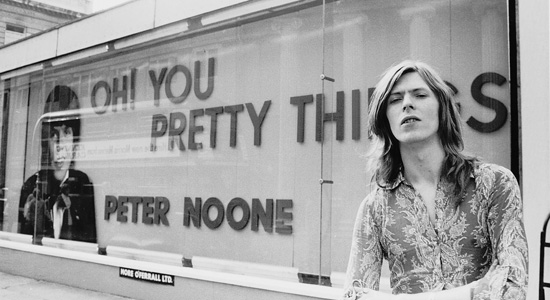
Thursday, July 6, 1972. Britain’s youth tune in to the BBC’s Top Of The Pops. They are confronted by a performance as stylish, subversive and iconic as the Beatles on Ed Sullivan or, later, the Sex Pistols creating drunken havoc on the Bill Grundy show. The hype had been building through the year, but nothing prepared the nation for the eye-popping vision of David Bowie flouncing shamelessly through “Starman” with the Spiders From Mars. Parents were appalled, but the kids suddenly had a new pop messiah, and a bright new future beckoned. By the end of the year, Bowie had reinvented himself as Ziggy Stardust and taken America.
It wasn’t an overnight success story. Far from it. Bowie had been floundering around the British pop hinterland for almost a decade, flitting from image to image with little commercial success. And it’s this trajectory—from stumbling beginnings to cultural lightning rod—that’s captured on Five Years 1969-1973, a magnificent behemoth of a boxed set.
Technically speaking, it might be better renamed Four Years (which doesn’t quite have the same ring or the play upon the song title), but you get the gist, as 1969-1972 was where Bowie found his voice as an artist, building and cementing his legend. 1973 was the year he consolidated his newfound status as the world’s preeminent postmodern pop star, witnessed here by the nervy, wired glam-rock thrills of Aladdin Sane and the odds ‘n’ sods of Pin Ups. Elsewhere, Bowie fans with money to burn get all four of his other (remastered) studio albums of the period (David Bowie, The Man Who Sold The World, Hunky Dory, The Rise And Fall Of Ziggy Stardust And The Spiders From Mars), two live albums (Live Santa Monica ’72, the Ziggy motion-picture soundtrack), plus a 2003 Ken Scott remix of Ziggy and—one for the completists—Re:Call 1, a collection of rarities and unreleased tracks, as is de rigueur with such collections.
The average Bowie obsessive will most likely own a great deal of this, and any fan of pop music in general with even a modicum of taste and style should own at least two of these albums (Hunky Dory and Ziggy, in case you were wondering). So, what’s the point, other than to enrich the already substantial Bowie coffers? It’s an historical artifact, one put carefully together by Dame David himself, an attempt to ensure his historical legacy, one that follows his path from uncertainty to legend—and in doing so, altering the course of pop music and defining a decade. And really, you can’t ask for much more than that.
—Neil Ferguson







